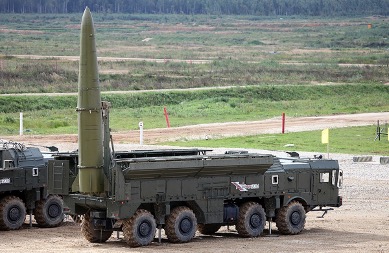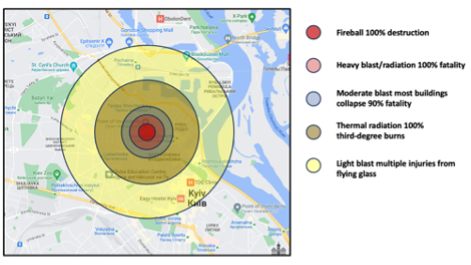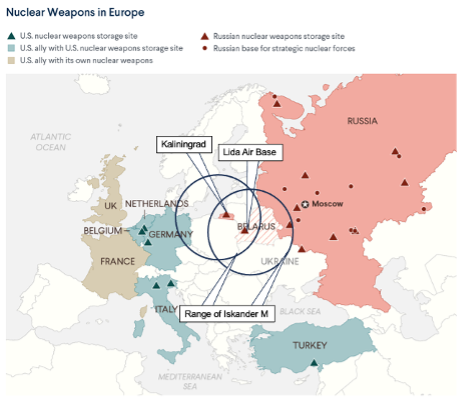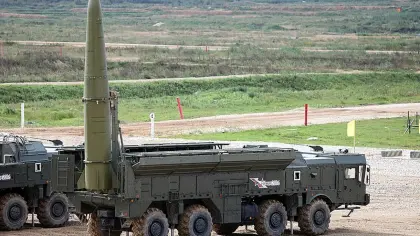With both Presidents Putin and Lukashenko claiming that Moscow has begun delivery of tactical nuclear weapons to Belarus and the hawks within the Kremlin further escalating their nuclear rhetoric, the threat of the use of nuclear weapons has reached its highest level since the 1962 Cuban missile crisis.
This, combined with the number of irrational actions Putin has already taken in pursuing his war, leads Kyiv and its Western allies to fear that he could actually resort to the use of tactical nuclear weapons (TNW).
JOIN US ON TELEGRAM
Follow our coverage of the war on the @Kyivpost_official.
Kyiv Post examines the threat in more detail: Is the use of such weapons at this stage in the war logical? What would their use achieve? What are the weapons systems involved and their capabilities?
What are tactical nuclear weapons?
A tactical nuclear weapon (TNW) or non-strategic nuclear weapon (NSNW) is a nuclear weapon that is designed to be used on a battlefield. Any weapon can be used as a nuclear delivery system which can include free-fall aircraft bombs, surface-to-surface (SSM) and air-to-surface missiles (ASM), artillery shells, land mines, depth charges, demolition charges and torpedoes among other things.
In the context of the war in Ukraine we are likely talking about short to medium range missiles such as the Iskander-M short-range SSM, which Russia announced it had transferred to Belarus in April.

Iskander-M on launcher
Photo: wikicommons

Moscow Prime Suspect for Sabotage Aimed at Disrupting Olympic Games
Like many Russian delivery systems, the Iskander-M is dual-use, which means it can be armed with a conventional as well as nuclear warhead. At the end of May, the Belarusian army held exercises during which it carried out training on its Iskander missiles. On June 14, Lukashenko said the country had already started receiving nuclear warheads from Russia.
Iskander-M, which is known in NATO as SS-26, is a mobile short-range ballistic missile system, that reaches an altitude of 50 km and a range of up to 500 km. In its final terminal flight phase, it becomes hypersonic, traveling at Mach 6 – 7 (2100–2600 m/s).
There are a range of nuclear warheads that can be fitted ranging from 5 to 50 kilotons. A kiloton is a measure equivalent to one thousand tonnes of TNT conventional explosives, although its effects will include more than just explosive blast. The likely effects of a 50 kiloton blast are shown in the diagram below.

In addition to nuclear warheads, the Iskander missiles can be fitted with a range of conventional warheads, including high-explosive fragmentation, cluster munition, a fuel–air explosive enhanced-blast, a bunker busting penetrator and anti-radar electromagnetic devices.
Where are the nuclear weapons?
We don’t know exactly how many TNW Russia holds but it is estimated to be around
2,000 compared with around 200 held by the US, half of which are based in Europe (under US control). The deployment by Washington of TNW in the countries of its allies was used by Moscow as a pretext for its decision to deploy weapons to Belarus.
Although neither Russia nor Belarus has confirmed where the weapons will be stored, the Federation of American Scientists used geolocation of a Belarusian TV news report to identify a possible base for the missiles to be the Lida air base, in western Belarus, which is also close to a former Soviet nuclear weapons storage facility.
In addition to Belarus, it has been long believed that Russia has already deployed Iskander-M missiles to Kaliningrad, the Baltic coast territory it holds between NATO and European Union members Poland and Lithuania. While it has not been confirmed that TNW are held in the enclave, Putin has threatened to station further nuclear and hypersonic weapons there in response to Finland and Sweden joining NATO.
Missiles launched either from Kaliningrad or Belarus could reach large parts of both Ukraine and Western Europe as illustrated in the map below.

Preparations for use
Because the Iskanders are dual-use, it potentially makes it more difficult to spot preparations for a nuclear strike. The focus of Western surveillance is to monitor the storage sites in which the warheads are held. This was done before but even more so since Moscow invaded Ukraine.
It is most likely that preparations for a nuclear strike would show in heightened activity around the depots as arrangements would have to be made to move the warheads. Electronic surveillance would also be used to identify any increase in communications between Russian forces, who insist they will control the TNW, the Belarusian military nuclear troops, the warhead storage sites and the locations where the missiles are located.
Will Putin use these (or other) TNWs?
The fear is that faced with a never-ending conflict or, even worse, defeat on the battlefield in Ukraine, Putin could conclude that the use of one or more TNW would save him and his regime from humiliation and ignominy.
Logically, from a western perspective, it would make no sense to do so, either tactically or strategically. While the use of TNW would be devastating at the target they would not guarantee a “victory” for Putin and would be a gamble that the West would not respond forcefully, not with their own nuclear weapons, but with conventional forces that would outmatch the highly degraded Russian forces.
The US has made it clear that the use of nuclear weapons by Putin in Ukraine would have “catastrophic consequences.”
The other, possibly overarching reason that might constrain him, is the position of China. President Xi has stated, at least publicly, that the use of nuclear weapons would be unacceptable. It seems that if he ordered a nuclear strike, however limited, he would be in danger of ending his strategic partnership with China.
Moscow has reminded the world that they could resort to the nuclear option since the war began. It has been seen by most as a tool to push back against Western weapons supplies to Kyiv, rather than a real ultimatum. Deploying TNW to Belarus, the first time the Kremlin has deployed nuclear missiles outside of Russia, has taken the rhetoric another step forward.
However crazy the West might consider Putin contemplating the use of the nuclear option might be, a month ago no one thought he would be desperate enough to destroy the Kakhovka dam in southern Ukraine and swamping thousands of square kilometers.
The positioning of TNW on the borders of three NATO countries and the increased threat it represents for a man who is in danger of losing not only the war but everything he holds dear is a threat that cannot be ignored.
You can also highlight the text and press Ctrl + Enter






